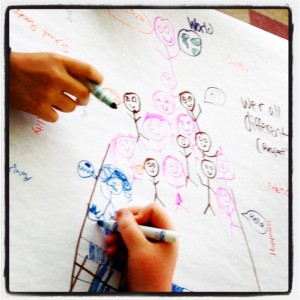Aug 29, 2014 Draw Your School or Workplace
 Purpose/Focus: community building, group norms, goal setting, social-emotional learning, 21st century skills, reflection, metaphor/imagery, multiple pathways, citizenship, collaboration, vision setting, responsibilities, creativity/imagination, communication, peer interactions
Purpose/Focus: community building, group norms, goal setting, social-emotional learning, 21st century skills, reflection, metaphor/imagery, multiple pathways, citizenship, collaboration, vision setting, responsibilities, creativity/imagination, communication, peer interactions
Materials: flip chart or butcher paper, markers/crayons for every person in the group
This activity focused on group norms initiates discussion and reflection on what ideal group behaviors look like, sound like, and feel like in order to create a shared understanding and vision around improving the school or workplace climate. It is a great follow up or lead into group norms agreement activities. This is especially effective when starting a new project or initiative or during times of transition such as grade level changes.
Facilitation Suggestions • Divide the group into teams of 4 to 6 people.
- Ask each person to choose a marker or crayon (this increases involvement, by making sure everyone has a tool for drawing/writing if they are inspired).
- Ask group members to think about their school or workplace (any changes taking place). Then have them work together to draw their ideal school or workplace.
- They can include some aspects of the physical plant, but the focus should be on how people interact(i.e., treat each other, talk to each other) within the space. What would be ideal? What does it sound like? What does it look like?
- Invite them to use words, symbols and drawings for their depiction.
- Ask that each group member be involved in some way.
- Allow 10 to 20 minutes, depending on the group.
- Then have each group stand or sit together and present their work to the rest of the group.
Outcomes/Reflections

This activity leads to reflection and discussion in both small and whole group settings about healthy group norms and acceptable behaviors. Time and time again, I find this conversation brings in the voices of people who don’t always contribute to verbal only or list making oriented discussions. This is an option for what ideally should be a series of ongoing activities and reflections on group norms during a group’s time together.
Resources/References: This group drawing variation was inspired by my work with middle schoolers at Twin Valley Middle School in Whitingham, VT and appears in my new book Inspired Educator, Inspired Learner 2014 by Wood N Barnes Publishing – available soon!



No Comments